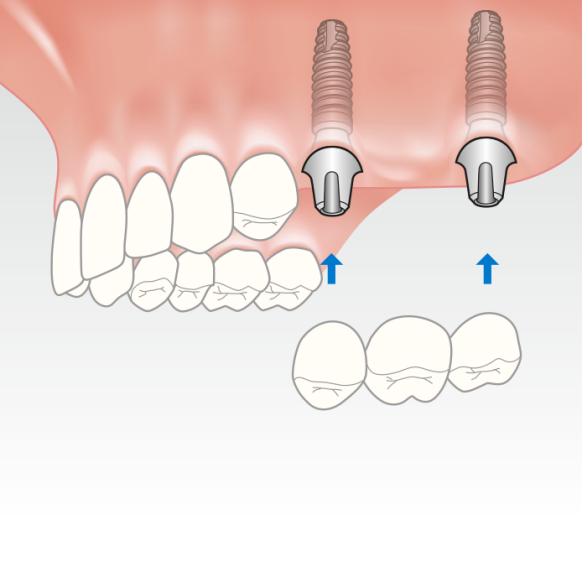
Replacing several teeth
If you have lost several teeth there are two solutions: separate crowns on dental implants or a bridge attached to several dental implants.

If you have lost several teeth there are two solutions: separate crowns on dental implants or a bridge attached to several dental implants.
Traditional solutions do not load the jaw bone like a natural tooth. This is why the bone atrophies over time and bridge components are often clearly visible.

This solution involves grinding down adjacent healthy teeth to support the bridge.
It does not load the jaw bone like a natural tooth. This is why the bone atrophies over time and bridge components are often clearly visible.

This solution involves the use of metal clasps on the adjacent healthy teeth. Over time the clasps may overload the retainer teeth and cause more tooth losses.

A removable prosthesis needs retainers such as small metal clasps attached to the neighboring teeth.
Over time the clasps may overload the retainer teeth and cause more tooth losses.
A dental implant is the optimal solution for anyone who is missing one or more teeth.

They look, feel and function like your natural teeth.
Courtesy: Prof. Clark Stanford, University of Iowa, Iowa City, USA

Anchoring dental implants in the jawbone stimulates bone tissue and gums, ensuring an attractive, esthetic result while helping to maintain facial structures.

Dental implants are made of pure titanium. This material is perfectly compatible with the body and over time becomes completely integrated with the bone tissue. Extensive scientific documentation from clinical studies confirms that implants enable very good results — over both the short- and long-term.

Replacement materials are available even after many years.
Implant abutments can be replaced at any time or adjusted to conform to a subsequent change in the prosthetic situation.
Dentsply Sirona offers a lifetime warranty to clinicians for titanium clinical components and five (5) years for clinical components manufactured in zirconia.*
(*For full warranty information, refer to the detailed terms and conditions on www.dentsplyimplants.com)

Healthy teeth do not need to be ground down to support the dental implants.

Dental implants do not require any adhesives to hold the new teeth in place.

The jaw is X-rayed to check the condition of the bone tissue and to determine the placement of the dental implant. An impression is made of the jaw and existing teeth, forming an important platform for the treatment planning.
There are two options for dental implant placement, depending on your clinical situation. In a one-step procedure, the dental implant is placed and then a temporary abutment is attached. In a two-step procedure, the dental implant is inserted and then covered by the gum, and left to heal. The abutment is attached at a later date. In both cases, a temporary crown is put in place.
A temporary crown is put in place, followed by a maximum healing period of three months for the lower jaw, and six months for the upper jaw. Innovative technologies and a growth-activating surface provide for secure and quick healing of the implant. Over time it becomes completely integrated with the bone tissue.
In a one-step treatment, the temporary abutment is replaced by a permanent one. The second part of a two-step procedure involves making a minor incision to open the gum and put the abutment in place. When the abutment is in place, a new impression is made.
The new tooth is now in place, and feels and functions like a natural tooth.

As with natural teeth, proper care and maintenance of your dental implant-supported teeth plays a significant role in preserving an optimal outcome over time.
Make sure to: